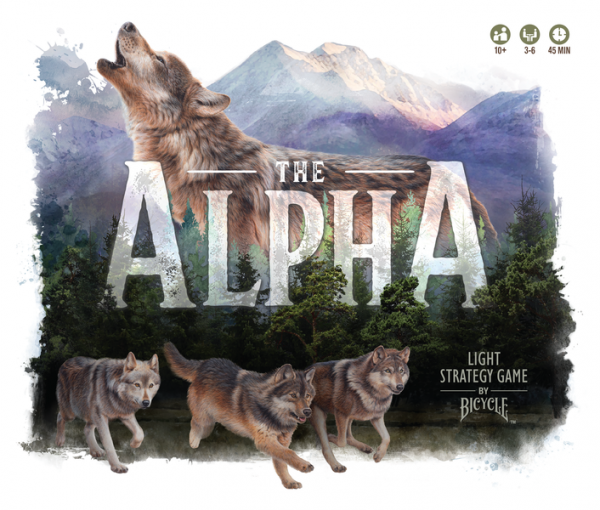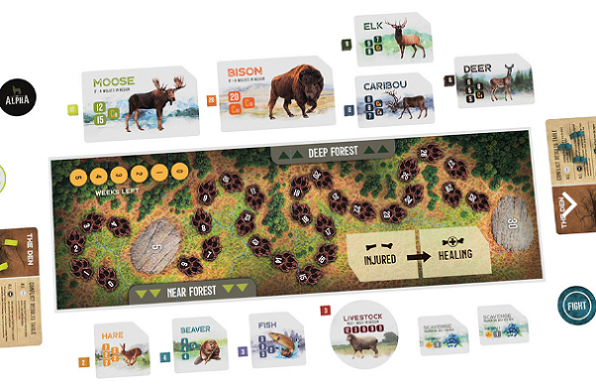Fight for Control of the Packs in Light Strategy Game The Alpha

Will your pack of hungry wolves dominate the forest or be reduced to scavenging what’s left behind by others?
A new game from Bicycle, The Alpha has players vying for control of hunts and using a prisoner’s dilemma mechanic to resolve conflicts.
Gameplay
Each player places one wolf meeple of their color on the scoring/food track and takes five wolf meeples for their personal supply. Each player also takes one alpha pair wolf meeple. Depending on player count, a different number of large and medium prey tiles are placed above the game board in the deep forest area and a number of a small prey tiles are placed below in the near forest area, along with one livestock tile and one-to-two scavenge tiles. Each prey tile represents a different type of animal and comes with its own unique die.
The game takes place over five rounds. At the start of each round, players take turns placing one of their wolf meeples or their alpha pair on a prey tile. If you place one on any of the tiles in the deep forest area, it costs you one food and you must move your wolf back one space on the scoring track to indicate this. Only one wolf can be placed on the livestock tile, and each player can only place one wolf each on a scavenge tile, however a scavenge tile gives each player with a wolf on it one food when resolved. Once everyone has placed all their wolves, you check each prey tile that has wolves on it. The player with the most wolves (an alpha pair counts as two wolves) is considered the dominant pack on the tile. If multiple players tie for the most wolves, they are all the dominant packs.
Next, for each tile with wolves you roll that tile’s die (for large prey tiles, if there are not at least five wolves present, then the hunt fails and the die is not rolled). If a die rolls a number, this is how much food resulted from the hunt. If it shows an X, the prey got away (if there is more than one dominant pack present on the tile, the die can be re-rolled). If it rolls the letter C with a number, then the number is the amount of food gathered and the C indicates that you flip the tile over to its carrion side for the next round only. A carrion tile is worth a set number of food and does not have you roll a die. The livestock tile’s die is unique in that it can roll a D, which means your wolf dies and is returned to the box. This is the only die in the game with this result.
After rolling the dice, you move on to the resolve phase. If there is only one dominant pack on a tile, that player takes all the food gathered from the hunt and moves their wolf up on the scoring track the appropriate number of spaces. If, however, there are two or more dominant packs, they have a conflict.
To resolve a conflict, each player who controls one of the dominant packs takes a conflict token and secretly turns it to the fight or share side and reveals their choice. If all players chose share, then the food is divided among them. If only one player chose fight, that player gets all the food. If two or more players chose to fight, they do not receive any food and will each have one wolf injured and unable to participate during the next round. The food then goes to any dominant packs that chose to share or, if there were none, any remaining packs on the tile who were not dominant packs.
The game ends at the end of the fifth round and the player who gathered the most food wins the game.

Review
The Alpha calls itself a light strategy game and it earns this designation well. The rules are straightforward, but it packs plenty of choice and player interaction into each round.
The information you need is presented really well, with each tile showing exactly what die results you can get from it. Each tile also has different, unique results. The amount of food you can gather doesn’t just differ from one size of prey to another, but between each individual tile. This means that when placing your wolves you’re presented with an almost push-your-luck style choice. The small rabbit has a five in six chance of getting you two food, while the bison has a one in two chance of getting you nothing, but if you’re lucky could roll you eleven or even twenty food. Of course, since the bison is a large tile, it also requires you to spend one food to even send a wolf there.
You need to weigh all of these considerations during every round, but you also need to balance them against what other players are doing and where they’re sending their wolves. There is some push-your-luck here too, as you can choose to send a wolf where you know you can’t claim dominance, simply hoping that the dominant packs will lose the food during the conflict phase and you can steal it.
The conflicts are clever and add yet another layer of trying to read the other players and trying to guess what everyone is going to do. This also builds off previous rounds nicely, making each new conflict that much more interesting as you weigh what people have already done and what they’re likely to do next.
We liked the fact that there are multiple tiles of each tile size, so that you can even swap them out between games, and would have liked even a few more to mix things up further. The game looks nice and all the components, particularly the wolf meeples, are well done.
There is definitely a sweet spot in the player count. While the game is playable with three, it’s more fun with more players — with more conflicts and wolves you have to account for, it ensures that the final round is more unpredictable and therefore more suspenseful.
The Alpha features a unique theme, light rules, and some really interesting strategic choices. Turns move quickly and keep the game going at a nice, brisk pace.
Pros: Variety between each tile, excellent player interaction
Cons: Better with more players, a few more tile types would have been nice but not necessary







